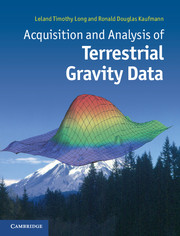Book contents
- Frontmatter
- Contents
- Preface
- 1 Gravitational attraction
- 2 Instruments and data reduction
- 3 Field acquisition of gravity data
- 4 Graphical representation of the anomalous field
- 5 Manipulation of the gravity field
- 6 Interpretation of density structure
- 7 The inversion of gravity data
- 8 Experimental isostasy
- A Appendix ACommon definitions and equations in potential theory
- B Appendix BGlossary of symbols
- References
- Index
7 - The inversion of gravity data
Published online by Cambridge University Press: 05 February 2013
- Frontmatter
- Contents
- Preface
- 1 Gravitational attraction
- 2 Instruments and data reduction
- 3 Field acquisition of gravity data
- 4 Graphical representation of the anomalous field
- 5 Manipulation of the gravity field
- 6 Interpretation of density structure
- 7 The inversion of gravity data
- 8 Experimental isostasy
- A Appendix ACommon definitions and equations in potential theory
- B Appendix BGlossary of symbols
- References
- Index
Summary
Introduction
The inverse problem in potential theory is an exercise in reducing an infinite distribution of possible solutions down to one that is physically realistic and acceptable to an experienced interpreter. This chapter formalizes the determination of distributions of densities given assumptions concerning the properties of the density anomalies and the causative structures. Although the densities of materials surrounding a gravity observation uniquely determine the gravity field, the gravity data alone cannot determine a unique distribution of densities. The density can vary smoothly within a geologic structure, or it can be discontinuous, such as at boundaries of distinct geologic units. In either smooth or discontinuous density distributions there exists an infinite variety in the densities that can be found to fit any set of gravity observations. The only restriction is that the anomalous densities fall above some maximum depth. In general, density is neither a smooth nor uniform function of position. Density is discontinuous across boundaries at all scales, from mineral grain boundaries to the edges of major geologic structures. The details of the density structure are usually so complex that a complete definition would be neither practical nor advisable. In most cases, average or bulk densities for geologic units may be constrained to fall within narrow limits and these limits may be used to limit the density models that generate the gravity anomaly. In effect, the limitations placed on density by the composition and physical condition of geologic units to a large extent define acceptable density structures. On the other hand, the non-uniqueness of gravity data cannot be escaped. There exists an infinitely large set of density models that will satisfy a given gravity anomaly and most of these are not physically realistic. The task of gravity data inversion is to automatically find geologically acceptable density structures that also satisfy the observed gravity anomalies. Hence, reasonable densities for the lithology and acceptable shapes for structures are used to constrain the search for the density structure in gravity data inversion. In the inverse problem, the assumptions are formulated as constraint equations, sometimes referred to as the cost functions. The role of the cost functions or constraints is to add sufficient information to allow a unique solution for a density model consistent with the observed anomalies and expressed constraints.
- Type
- Chapter
- Information
- Acquisition and Analysis of Terrestrial Gravity Data , pp. 129 - 148Publisher: Cambridge University PressPrint publication year: 2013



